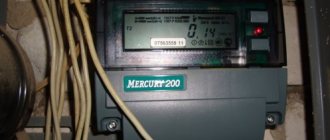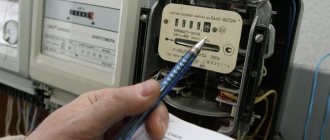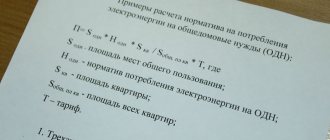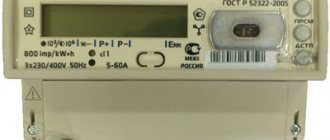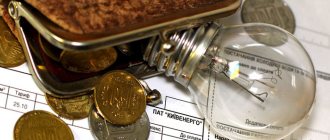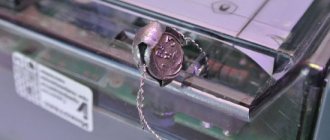It is necessary to transmit the data of an individual meter within a certain period of time. This ensures payment is calculated according to current tariffs. But in order to avoid discrepancies and errors, you need to correctly take the electricity meter readings. In fact, there is nothing complicated here, although not everyone knows where to look and which button to press to rewrite the necessary information.
How to take readings
Depending on the model of the electricity meter, different methods for obtaining information are used.
Old meters
Mechanical induction devices have been popular for quite some time. At the moment, they are gradually giving way to electronic IPUs, which provide better control of electricity consumption. Although the demand for classic meters is gradually decreasing, they are still found in private houses and apartments.
The device is single-tariff (single-phase), so there is no need to perform complex calculations to take readings. It is recommended to select a conditional day of each month for writing off data from the electric meter, preceding or included in the period for submitting information.
The procedure is quite simple:
- A standard mechanical apparatus has a dial with 5–7 digits, and as it works, the numbers change from 0 to 9. After one department has completed a full revolution, the next one begins. The dial is divided into two halves: the left one shows how many kW/h have been consumed since connection, the second (red) is separated by a comma and indicates tenths (hundredths) of a kilowatt.
- It is necessary to write off the main part of the characters 000024.8 (seven-digit order). The basis is 000024 kW/hour.
- Depending on the requirements of the management company or resource supplying organization, the information received must be submitted without changes or the difference between the current and previous values must be independently calculated. So, if over the past month the readings were 000003, then: 000024–000003=21 kW/h.
In both old and new mechanical electricity meters, the numbers that are not taken into account in the calculations are clearly highlighted at the end of the number row
The process may be difficult due to the counter resetting to zero after reaching the maximum value. In such a situation, you must first write down the old data. For example, for May (conditionally) it was 999969 (without a decimal point), the new information is 000003 (1 is substituted at the beginning, the result is 1,000003).
1 000003–999969=34 kW/h (current readings).
It is necessary to understand that any illegal attempts to change information about electricity consumption will lead to serious trouble.
On a note! There are mechanisms in which there is no division into main and auxiliary numbers. In such a situation, you need to read and enter all available numbers into the receipt.
New counters
Modern single- and three-phase metering devices differ significantly from mechanical ones. The main difference is that IPUs are equipped with an electronic dial and can be multi-tariff, which provides significant savings in energy consumption. To correctly determine the readings, you need to understand the available devices.
The following varieties are distinguished:
- single tariff, the readings of which are not divided into zones;
- two-tariff – T1/T2;
- three-tariff – T1/T2/T3.
Data is collected from such devices as follows:
- You need to press a button on the mechanism body. It can be called differently, depending on the IPU model, most often - “PRSM”, “Input” or “Frame”.
- After pressing, the required values sequentially appear, which have the corresponding signatures - T1, T2 or T3.
- The main current indicators of 5–6 digits to the decimal point are written off one by one, depending on the type of counter.
- On an electronic display, the characters are separated by a noticeable comma, and in some IPUs the hundredths and tenths are significantly smaller.
- The information is transmitted directly to the management company or supplying organization or calculated independently.
In electric meters with an electronic display, after pressing the control key, the data is displayed on the screen: the number of kilowatt-hours consumed and the tariff number (indicated in the upper left corner)
Explanation of symbols for various electronic devices:
- Single tariff. Reflect the total resource consumption without division.
- Two-tariff. T1 – day zone (from 7 am to 11 pm), T2 – night period (from 23.00 to 7.00).
- Three-tariff. T1 – peak zone, which has two time periods: from 7.00 to 10.00 and 17.00 to 21.00; T2 – night (from 23.00 to 7.00); T3 – half-peak zone (from 10.00 to 17.00 and from 21.00 to 23.00). Time periods may vary by region.
The multi-tariff IPU must be correctly connected and pre-configured so that it records readings exactly for the allotted period. In some situations, this may require agreement with the utility provider.
Before purchasing and connecting multi-tariff meters, you should consult your energy supply company about the possibility of using them in your region
How is ODN calculated?
Everyone has the right to know what they pay for
For the sample, we will introduce an indicator that will mean a part of one apartment from the total area of the building.
Example formula:
KOP = PKV / PD
- KOP – payment coefficient;
- PKV – square footage of this apartment;
- PD – area of the house.
For example, the total area of the house is 1900 m2, and part of a particular apartment is 80 m2, which means the indicator will be equal to 0.042.
What to do if there is no communal meter?
The owner of the apartment has a choice - to assign the responsibility for calculating electricity consumption according to the meter to the building management employees or to enter into an agreement to pay for the electricity supply with the company that provides energy sales.
Government Order No. 307 dated May 23, 2006 states that institutions providing energy supply are required to receive payment for services provided no more than the stated norms in the region. Electricity calculations are carried out in the same way as in houses that do not have an electricity meter:
PEL = IEL x PNL x COP
- PEL – electricity consumed per month;
- IEL – ODN index per 1 m2;
- PNZh – total area of common areas.
Let's take as an example the same house with an area of 1900 m2, in which non-residential premises are 400 m2. With an indexation of ODN equal to 1.25 kW, the indicator of electricity consumed per month is: PEL = 1.25 x 400 x 0.042, that is, 21 kW.
Calculation of readings with an installed meter
If you have entrusted the readings of electricity consumption to the company that provides electricity, then when calculating them, the difference between the total house consumption of all dwellings and energy according to the standards in premises that do not have a meter is taken.
We use our conditional apartment with an area of 80 m2 for an example calculation:
OEL =(OOD-OKV)/KOP
- OEL – parameter of electricity consumed in a certain apartment;
- OOD – total electrical energy of the entire multi-apartment building;
- OKV - the total expense of the owner or tenant of the home.
If according to the general building meter of a given house, 12,500 kW was consumed, and the amount of electricity used by all residential premises is 11,930 kW, then the OEL of our apartment will be 27 kW.
Important: you need to constantly regulate the electricity calculations at the one-way distribution point, and also send readings to the service company every month so that there are no incorrect calculations and overpayments.
If the ODN calculation has not been sent for a certain apartment for a long period of time, then the average amount of consumption for one month is taken into account.
The balance of used and unpaid electricity is divided among residents in proportion to the electricity consumption in each apartment.
If you have an old-style electricity meter (disk type), you can calculate the energy consumption of all electrical appliances currently running using a spinning disk.
To do this, you need to calculate the number of full revolutions of the disk (the beginning of each subsequent circle is indicated by a black mark) in 1 minute.
Let's assume this figure is 25. We multiply the resulting value by 60 (the number of seconds in a minute), thereby obtaining 1500. One kW of energy is equal to 1200 revolutions. Therefore, the energy consumption of all electrical appliances currently operating in your apartment will be: 1200 / 1500 = 0.8 kW.
How to calculate electricity using a meter
To eliminate errors, it is necessary to carry out the calculation correctly.
Where to find tariff information
To independently determine the amount of electricity payment for the current period, you need to know exactly the cost of the service. Depending on the region of the Russian Federation, as well as additional parameters (type of settlement, availability of certain electrical appliances and rates at different times of the day), the tariff for the population may differ significantly.
You can find out the cost for a specific territory as follows:
- Check on the website or at the office of the utility service provider. The data must be indicated on stands in specialized payment centers.
- When tariffs increase, information is published in the official press and on the website of the regional commission that deals with this issue. The department’s website also has an online calculator that roughly calculates the fee for a specified time period.
- Look on the receipt. During the period when tariffs increase, some discrepancies are possible.
Attention! It is not recommended to use unofficial sources of information, as they may contain unverified or outdated information.
Calculation
It is not difficult to calculate the payment for consumed electricity; to do this, you need to follow a certain scheme, depending on the type of device.
Single tariff electricity meter
Conventionally, the current readings are 000354, for the last month – 000296.
The tariff for Moscow residents who live in gasified houses that do not fall under the territory equated to rural areas for the second half of 2022 is 5.38 rubles. per kW/h.
Based on the available values, the calculation of the expense and payment amount for the current month will be as follows:
354–296=58 kW/h x 5.38 rub. = 312.04 rub.
Two-tariff IPU
Electric meter readings for the new billing period: T1 – 000898, T2 – 000576. Previous values: T1 – 000840, T2 – 000539.
The tariff for the peak zone in Moscow (in houses with gas stoves) is 6.19 rubles, for the night period - 1.92 rubles.
You need to determine consumption and payment in stages; first you need to calculate current consumption:
T1. 898–840=58 kW/h x 6.19=359.02 rub.
T2. 576–539=37 kW/h x 1.92=71.04 rub.
Total for the month: 359.02+71.04=430.06 rub.
Three-tariff electricity meter
It is necessary to take readings from three zones: T1 – 000587, T2 – 000456, T3 – 000832. Data for the past month: T1 – 000545, T2 – 000415, T3 – 000780.
Tariffs by time: peak zone – 6.46 rubles; night – 1.92 rubles; half peak – 5.38 rub.
To find out how much you need to pay per month, you need to count your expenses sequentially.
T1: 587–545=32 kW/h x 6.46=206.72 rub.
T2: 456–415 = 41 kW/h x 1.92 = 78.72 rub.
T3: 832–780 = 53 kW/h x 5.38 = 285.14 rub.
Next you need to add up all the data:
206.72+78.72+285.14=570.58 rub.
This is the amount you need to pay for light.
It is taken into account that the final figures in the receipt may differ slightly: you need to pay attention to the “ONE” line, which reflects the general readings for the house and is included in the payment.
How to calculate electrical energy consumption
In an era when it is difficult to imagine your life without electrical appliances, and the price of energy is constantly rising, it is important to be able to plan and calculate. Calculating electricity consumption is important both for planning future costs for paying electricity bills and for determining the loss caused by unaccounted use of electricity
Options for determining energy consumption.
- Each electrical device contains a label indicating its technical characteristics, the value of which is measured in Watts (W or W) - this is the electrical power. On some equipment, for example, a microwave oven, a range of values may be indicated, for example, from 800 to 1000 W, in which case it is customary to take the average value of 900 W.
Also, the approximate operating time of each electrical energy consumer is known. The refrigerator operates no more than 8 hours a day and so on for each appliance. Only the operating times of the heater, fan and air conditioner may vary significantly depending on the season. In this case, it would be more accurate to carry out different calculations for each time of year.
Next, the power of each electrical appliance is multiplied by its operating time, in hours per day. After that, the total consumption for the apartment (house, enterprise) is found and divided by 1000, since the standard unit of consumption is kWh, the formula in this case is sufficient, simple, and as a result of the calculation, the electricity consumption per day is obtained. By multiplying the number by the number of days in a month or year, you can determine the monthly and annual consumption, respectively.
Further calculations do not differ from the first option.
As a rule, an electric meter quite accurately calculates the amount of electricity consumed. Based on its readings, you can quite accurately determine the amount of energy consumed. To do this, it is enough to subtract the previous ones from the current readings of the device. The resulting value will be the consumption for a specific period of time.
In the case of indirect measurement meters, that is, with current and (or) voltage transformers, the resulting number must be multiplied by the transformation ratio.
Average power values of electrical appliances
Sometimes in everyday life it is quite difficult to determine the power value indicated on the tags, and the readings of the electric meter are called into question. The table shows typical power values of common electrical appliances.
Name of electrical appliance Power, W
Microwave 1000
Incandescent lamp 75
The data given in the table may differ significantly from the real ones, since now there are quite a lot of modifications of the same electrical appliance.
In cases where it is impossible to determine the exact power of the device and there is no passport data, specialists often use current measuring instruments, an ammeter or clamps.
Energy supply organizations often use electricity consumption calculations in case of detection of unmetered electricity consumption and non-contractual electricity consumption. In this case, the calculation is made using special coefficients, and, as a rule, the value is higher than the actual electricity consumed.
By correctly applying the above formulas and making a reverse calculation, you can easily calculate the power consumption of electrical appliances, knowing the monthly consumption, and even the average current value. This data will help determine the cross-section of current-carrying conductors and protective equipment.
Retrieving information and calculations for different models
Although the operating principle of modern IPUs is almost identical, depending on the variety there may be some differences:
- "Mercury 200". The “Enter” button is pressed, after which the time, date, readings by zone and total flow appear. The letter designation of the tariff is in the upper left corner. According to the described calculation example for a specific territory, the total payment amount is calculated.
- "Energymera". The most common are two- and multi-tariff modifications. Readings from this meter are taken according to a scheme similar to the previous option. The main difference is that you need to press the "PRSM" button.
- "Micron". It is not difficult to take readings from such a meter, provided that certain nuances are observed. At the bottom left side of the case there is a button, when pressed, the necessary information is displayed. A special feature of the device is that the designations of tariff zones T1, T2 or T3 do not appear; they are already signed at the bottom of the screen and highlighted with a tick. The payment amount is calculated according to the standard scheme.
- Saivan. The most economical option that is popular. It differs from others in the absence of a button that highlights specific values and shows data sequentially with a small interval. The necessary parameters are recorded and checked, for which it is necessary to let the counter go around in a circle. The calculation depends on the modification of the electricity meter and the current tariff.
Advice! To eliminate errors when taking readings, you must first familiarize yourself with the product data sheet, which contains the correct algorithm of actions.
When choosing an electric meter, it is advisable to give preference to domestic models or meters manufactured in the CIS, since imported options may not be adapted to our networks
Methods for determining the electricity consumption of household appliances and tools
The average electricity consumption in citizens' apartments per month is the sum of the total electricity consumption of all electrical appliances used by its residents. Knowing the electricity consumption for each of them will give an understanding of how rationally they are used. Changing the operating mode can provide significant energy savings.
The total amount of electricity consumed per month in an apartment or house is recorded by the meter. There are several ways to obtain data for individual devices.
A practical way to calculate electricity consumption based on the power of an electrical appliance
The average daily electricity consumption of any home appliance is calculated using the formula; just remember the basic characteristics of electrical appliances. These are three parameters - current, power and voltage. Current is expressed in amperes (A), power in watts (W) or kilowatts (kW), and voltage in volts (V). From the school physics course, we remember how electricity is measured - it is a kilowatt-hour, it means the amount of electricity consumed per hour.
All home appliances are equipped with labels on the cable or on the device itself, which indicate the input voltage and current consumption (for example, 220 V 1 A). The same data must be present in the product passport. Based on current and voltage, the power consumption of the device is calculated - P=U×I, where
- P – power (W)
- U – voltage (V)
- I – current (A).
We substitute the numerical values and get 220 V × 1 A = 220 W.
Next, knowing the power of the device, we calculate its energy consumption per unit of time. For example, a regular liter electric kettle has a power of 1600 W. On average, he works 30 minutes a day, that is, ½ hour. We multiply the power by the operating time and get:
1600 W × 1/2 hour = 800 W/h, or 0.8 kW/h.
To calculate costs in monetary terms, we multiply the resulting figure by the tariff, for example, 4 rubles per kWh:
0.8 kW/h×4 rub.=3.2 rub. Calculation of the average monthly fee - 3.2 rubles * 30 days = 90.6 rubles.
In this way, calculations are made for each electrical appliance in the house.
Counting electricity consumption using a wattmeter
The calculations will give you an approximate result. It is much more reliable to use a household wattmeter, or energy meter - a device that measures the exact amount of energy consumed by any household device.
Digital wattmeter
Its functions:
- measuring power consumption at a given moment and over a certain period of time;
- current and voltage measurement;
- calculation of the cost of consumed electricity according to the tariffs you have set.
The wattmeter is plugged into a socket and the device you are going to test is connected to it. The display shows power consumption parameters.
Current clamps allow you to measure the current and determine the power consumed by a household appliance without disconnecting it from the network. Any device (regardless of manufacturer and modification) consists of a magnetic circuit with a movable disconnect bracket, a display, a voltage range switch and a button for recording readings.
Measurement procedure:
- Set the desired measuring range.
- Open the magnetic circuit by pressing the bracket, place it behind the wire of the device under test and close it. The magnetic core must be located perpendicular to the power wire.
- Take readings from the screen.
If a multi-core cable is placed in the magnetic core, the display will show zero. This happens because the magnetic fields of two conductors carrying the same current cancel each other out. To obtain the required values, measurements are carried out on only one wire. It is convenient to measure energy consumption through an extension cord-adapter, where the cable is divided into separate cores.
Determining energy consumption using an electric meter
A meter is another simple way to determine the power of a household appliance.
How to count light using a meter:
- Turn off everything in the apartment that runs on electricity.
- Record your readings.
- Plug in the desired device for 1 hour.
- Disable it and subtract the previous readings from the received numbers.
The resulting number will be an indicator of the electricity consumption of the individual device.
Where to submit readings
It is necessary to take data from the electricity meter within a specified period, which precedes or includes the period allotted for sending information; the exact interval is specified in the contract.
Testimony from the public is received by the utility service provider. This role may be played by a supplying organization, a management company or a homeowners' association. It is taken into account that these powers can be delegated to special settlement organizations or auxiliary institutions.
You can transmit electricity meter readings using different methods:
- Enter the information on the receipt and bring it to the billing department.
- Send via Internet. To do this, you need to fill out the appropriate table on the organization’s website or in your personal account.
- Indicate on the form that you want to put it in a special box installed in various institutions.
There are also other modern methods that involve the use of technical devices.
Why do you need to calculate electricity?
Every month, the apartment owner must record readings from the electricity meter. Values are expressed in kilowatts per hour (kW/h). The recorded data must be shown to a full-time representative of the organization involved in energy supply, or the required amount must be calculated independently. The calculation is not difficult; in some meter models, for convenience, the required values are highlighted in color. A meter is installed at the entrance to the apartment and after the transformers.
How to notify an organization about energy costs:
- Come to the service office in person and report the readings taken.
- Send data via the Internet.
- Call the organization and dictate the information over the phone.
- Include readings in the column when paying receipts.
After this, the required amount is paid.
Payment Methods
Today, the population is provided with several main options for paying for consumed electricity:
- Bank branches and self-service devices. You need to transfer money using a payment document or through a special section of the terminal.
- Personal account, payment services, mobile applications. To do this you will need access to the Internet.
- Post offices or payment centers.
- Directly to the utility service provider through branch cash desks.
Regardless of the chosen method, you must receive confirmation of the completed payment.
Load power calculation
Sometimes there is a need to find out how much individual electrical appliances consume at a given time. To do this, you need to turn off unnecessary devices and turn on the ones you need. Next, count the number of disk revolutions or the number of pulses per minute and calculate the load power using the formula:
where W is the power consumption per hour, n is the number of pulses or disk revolutions over a certain period of time, Imp is the number of pulses or disk revolutions corresponding to 1 kW*h, t is time in seconds.
If the gear ratio of the meter is 1 kWh - 600 disk revolutions, the meter makes 8 revolutions in 60 seconds, then its load power will be:
What kind of lighting do you prefer?
Built-in Chandelier
Calculations for apartment buildings
The question of how to calculate the electricity consumed by the meter is different for residents of apartment buildings. After all, they are required to pay not only for their personal use of energy, but also for its costs in elevators, attics, internal parking lots, and so on.
Important! In this case, the total payment amount for each is calculated using two counters: a common house counter and an individual counter. Thus, the total amount of electricity that residents use in one way or another is taken into account. The general house payment directly depends on the area of the apartment occupied by the family.
Payments for general household needs are calculated according to approved tariffs and legally developed formulas.
Timely payment of personal bills for consumed electricity will save you from penalties and fines.
Expert opinion
Viktor Pavlovich Strebizh, lighting and electrical expert
Any questions ask me, I will help!
In addition, by calculating the cost of payment for the entrance once, you can use the resulting value until one of the formula indicators changes its value. If there is something you don’t understand, write to me!
Saving Tips
There are two ways to reduce your electricity bill, both of which involve reducing consumption:
- You can independently regulate consumption by turning off the most “gluttonous” devices. To calculate how much they consume, you can check their data sheets or turn off all devices and turn on only the ones you need. The value will be immediately reflected on the electricity meter.
- You can also switch to “night” mode, shifting the main load on the network to the dark. This will reduce costs, but may not be very beneficial for people who sleep at night, but it will help in some situations. For example, if you postpone making jam or drying mushrooms in the oven overnight, you can reduce your bills a little.
Another option would be to use appliances with minimal consumption, especially large appliances and lamps.
To pay for electricity, you only need to know a few data: the amount of electricity consumed and the tariff. You can find out both on your own if you have a meter and the Internet.
You may also be interested in an article on how to pay for electricity using a meter.
Read an article about methods of transmitting electric meter readings here.
Watch an interesting video that gives practical advice on saving electricity so that the payment for electricity on the meter is minimal:

